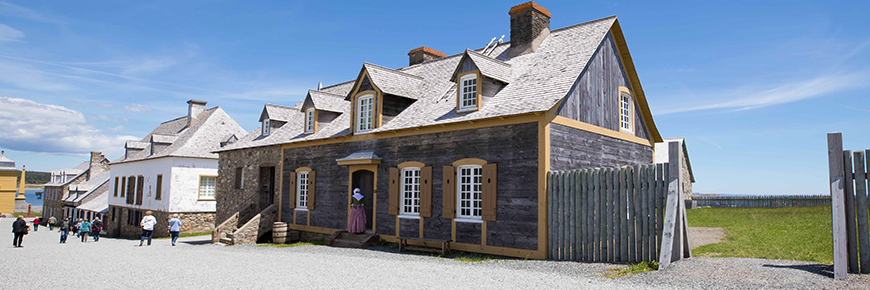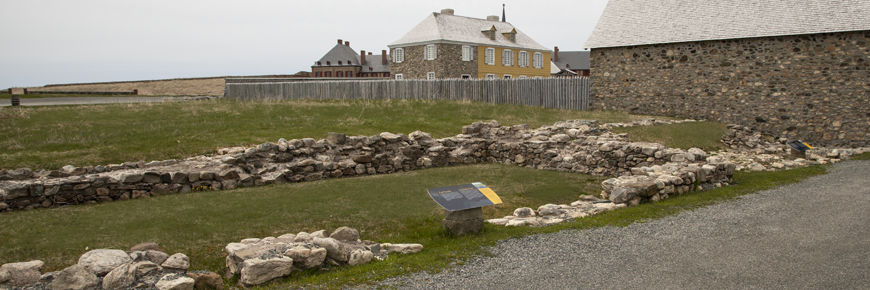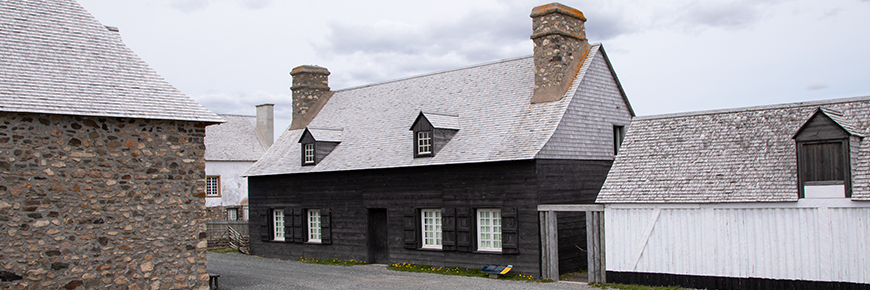
Le Neuf de la Vallière Property
Fortress of Louisbourg National Historic Site
The solid permanence of this house and its two stone storehouses suggests the colonial commitment of many of Louisbourg’s people.
The owner of this property, Louis Le Neuf de la Vallière (1708-1787), was the grandson of a Canadian soldier who had become governor of Acadia. De la Valliêre, who was born in French Newfoundland and lived in Louisbourg throughout its existence, was a lieutenant in the garrison at Louisbourg in 1744. Over several generations in the colonies, his family had severed most of its ties to France. Exiled there after the final conquest of Louisbourg, with Acadia, Newfoundland, Île Royale and Canada all lost, de la Vallière still hoped to return here. Eventually he went out to French Guiana instead, while his brother made a new start on Saint-Pierre and Miquelon. In the course of the eighteenth century wars some local families returned to this region from four or five successive exiles.
Explore the range of goods contained in the attached warehouse, reflecting this military family’s extensive involvement in maritime trade. For another sign of permanence, inspect the elaborate pavé floor of the detached de la Valliêre storehouse around the corner from Rue Toulouse, on Rue Royale, all original work from the eighteenth century building.

The Loppinot and Fizel Properties (ruins)
Are the streets muddy today? In a wet climate, on rocky ground, every householder used the technology of the time to keep his home dry. The archeologists who investigated these foundations found a carefully constructed stone-lined drain still carrying water out under the door and beneath the street.
Grandly named, Jean-Chrysostome Loppinot was another colonial officer without the French estates that usually supported an aristocratic standard of living. Loppinot lived more simply and gambled that trade and fishing investments would sustain his household of thirteen. In the summer of 1744, when war made commerce hazardous, Loppinot put a little money into a pair of local privateers. The Loppinots also had military commitments. Jean-Chrysostome served in both sieges and his younger brother was killed in action during the first one.
Beyond the Loppinot ruins, the remains of Julien Fizel’s inn mark the corner of Rue Royale and Rue Saint-Louis. An immigrant from Normandy, Fizel made this house the centre of a diversified trade. He ran a retail shop nearby~ raised live¬stock, and owned coastal boats and a fishing property. Fizel married twice, and when he was accidentally shot dead in 1757, he left a large estate to support his pregnant wife and ten children.
Attacked by a fire in 1762, the Fizel house was pulled down to stop the blaze from spreading. Archeologists found remains of walls and chimneys lying in the ruins when they excavated here.
Turning back toward Rue Toulouse, pass the windowless stables on the right to reach the Dugas property.

The Dugas Property
An exchange of property and services built a twin-chimneyed duplex here in 1722.
Dominique Detcheverry, the Basque blacksmith who owned the land, hired an Acadian carpenter named Joseph Dugas to build the house, and as payment he gave the Dugas family the western half of the building. Later Dugas acquired the whole house. An outbreak of smallpox in 1733 claimed the lives of Dugas, three of his daughters, and their slave. His widow married a captain of the compagnies franches de la Marine, Charles Saint-Etienne de la Tour. Dugas’ youngest daughter, Jeanne, remained in North America after the fall of New France and was among the founders of Chéticamp in the 1780s. She is recognized as a person of national historic significance.
The families of artisans like Dugas and Detcheverry were the working class heart of Louisbourg, less prominent than the military and commercial elite but more rooted in the town than transient sailors and barracked troops. They combined their skills with imported tools and materials to contribute something to every house in Louisbourg. The streetscapes of the town are the product of their art, and an exhibition in the Carrerot house presents their skills and techniques. The foundations between this house and the Carrerot property seem to have been laid in 1745 for another building project, one that was interrupted by the siege.
At the Carrerot property, turn right to visit the row of homes lining the slope of Rue Toulouse.
Related links
- Desroches House
- Dauphin Demi-Bastion and Gate
- Embrasures at Lartigue
- Lartigue House
- Artillery Storehouse and Forge
- The King's Bakery
- Duhaget Property
- De la Perelle Property
- Engineer's Property
- Rodrigue Property
- De Gannes Property
- The King's Bastion
- McLennan Centre
- Through the town to the quay / De la Plagne Property
- Carrerot Property
- Benoist Property
- L’Epée Royale
- Magasin du Roi (King's Storehouse)
- Hôtel de la Marine
- Grandchamp Property
- Frédéric Gate
- Commissaire-Ordonnateur’s Property
- Marie Marguerite Rose plaque
- Eastward along the Quay
The reconstructed site

| On the map | Building name |
|---|---|
| 1 | Desroches House (Wheelchair accessible) |
| - | Dauphin Gate |
| - | Dauphin Demi-Bastion |
| 2 | Powder Magazine |
| 3 | Barracks |
| 4 | Postern Tunnel |
| 5 | Embrasures at Lartigue |
| 6 | Lartigue House (Wheelchair accessible) |
| - | Lime Kiln |
| 7 | Artillery Storehouse |
| 8 | Artillery Forge |
| 9 | King's Bakery Food service |
| - | Woodlot |
| 10 | Duhaget House (Wheelchair accessible) Garrison and Fortifications Exhibit |
| - | Icehouse |
| 11 | De la Perelle House (Wheelchair accessible) Congrégation de Notre-Dame Exhibit |
| 12 | De la Perelle Storehouse |
| 13 | Engineer's Residence |
| 14 | Laundry and Stables |
| 15 | Rodrigue House |
| 16 | Rodrigue Storehouse |
| 17 | De Gannes House (Wheelchair accessible) |
| 18 | Guardhouse |
| - | King's Bastion |
| 19 | Military Chapel |
| 20 | Governor's Apartments |
| On the map | Building name |
|---|---|
| 21 | King's Bastion Barracks Reconstruction, Tools of War, and Archeological Typography Exhibits |
| - | King's Garden |
| 22 | McLennan Centre (Wheelchair accessible) (Wifi available) Virtual Reality Experience |
| 23 | De la Plagne (Wheelchair accessible) (Information) |
| 24 | De la Vallière House Mi'kmaw Interpretive Centre |
| 25 | De la Vallière Storehouse |
| 26 | De la Vallière Storehouse II |
| - | Fizel and Loppinot Properties |
| - | Dugas House |
| 27 | Carrerot House Building Techniques Exhibit |
| 28 | Benoist House (Wheelchair accessible) (Gift shop) |
| 29 | L'Épée Royale Café (Wheelchair accessible) Food service |
| 30 | King's Storehouse |
| 31 | Hôtel de la Marine (Wheelchair accessible) Food service |
| 32 | Grandchamp House (Wheelchair accessible) Food service |
| - | Frédéric Gate |
| - | Carcan |
| 33 | Grandchamp Inn (Wheelchair accessible) Food service |
| - | Destouches House |
| 34 | Ordonnateur's Residence (Wheelchair accessible) Recollecting Lives Exhibit & Harbour Gallery |
| 35 | Bigot Storehouse |
| 36 | Stables |
| - | Louisbourg Cross |
| 37 | Marie Marguerite Rose plaque |
| - | Eastward along the Quay |
| - | Ruins Walk |
- Date modified :